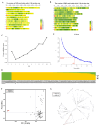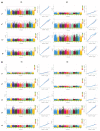Genetic Diversity and Genome-Wide Association Study of Total Phenolics, Flavonoids, and Antioxidant Properties in Potatoes (Solanum tuberosum L.)
- PMID: 39684503
- PMCID: PMC11640895
- DOI: 10.3390/ijms252312795
Genetic Diversity and Genome-Wide Association Study of Total Phenolics, Flavonoids, and Antioxidant Properties in Potatoes (Solanum tuberosum L.)
Abstract
Genetic diversity of nutritional quality traits is crucial for potato breeding efforts to develop better varieties for the diverse market demands. In this study, the genetic diversity of 104 potato genotypes was estimated based on nutritional quality traits such as color parameters, total phenolic content, total flavonoid content, 2,2-Diphenyl-1-picrylhydrazyl (DPPH), and 2,2-azino-bis-(3-ethylbezothiazoline-6-sulphonic acid) radical scavenging potential across two environments. The results indicated that environment II, Hangzhou 2020, exhibited higher bioactive compounds and antioxidant properties than environment I, Hangzhou 2019. The colored potato accessions exhibited higher levels of total phenolic content, total flavonoid content, DPPH, and ABTS activities than the white potato accessions, indicating the superiority of the colored to white potato accessions. The genome sequencing identified 1,101,368 high-quality single-nucleotide polymorphisms (SNPs), and 141,656 insertion/deletions (Indels). A population structure analysis revealed that genotypes can be divided into two subpopulations. Genome-wide association studies (GWAS) identified 128 significant SNPs associated with potato's color, total phenolic content, total flavonoid content, and antioxidant properties. Thus, the study provides new opportunities for strategic breeding and marker-assisted selection of ideal varieties and favorable alleles to enhance bioactive compounds and health-beneficial properties.
Keywords: antioxidant properties; environment; genetic diversity; genome-wide association study; nutritional quality; potato.
Conflict of interest statement
The authors declare no conflict of interest.
Figures





Similar articles
-
Starch phosphorylation associated SNPs found by genome-wide association studies in the potato (Solanum tuberosum L.).BMC Genet. 2019 Mar 18;20(Suppl 1):29. doi: 10.1186/s12863-019-0729-9. BMC Genet. 2019. PMID: 30885119 Free PMC article.
-
Effect of cold storage on total phenolics content, antioxidant activity and vitamin C level of selected potato clones.J Sci Food Agric. 2013 Aug 15;93(10):2437-44. doi: 10.1002/jsfa.6053. Epub 2013 Feb 12. J Sci Food Agric. 2013. PMID: 23400895
-
Antioxidant Contents and Antioxidant Activities of White and Colored Potatoes (Solanum tuberosum L.).Prev Nutr Food Sci. 2016 Jun;21(2):110-6. doi: 10.3746/pnf.2016.21.2.110. Epub 2016 Jun 30. Prev Nutr Food Sci. 2016. PMID: 27390727 Free PMC article.
-
New Frontiers in Potato Breeding: Tinkering with Reproductive Genes and Apomixis.Biomolecules. 2024 May 23;14(6):614. doi: 10.3390/biom14060614. Biomolecules. 2024. PMID: 38927018 Free PMC article. Review.
-
Bridging the gap between genome analysis and precision breeding in potato.Trends Genet. 2013 Apr;29(4):248-56. doi: 10.1016/j.tig.2012.11.006. Epub 2012 Dec 20. Trends Genet. 2013. PMID: 23261028 Review.
Cited by
-
Genotypic Diversity and Genome-Wide Association Study of Protein Content and Amino Acid Profile in Diverse Potato Accessions.Foods. 2025 Jun 9;14(12):2039. doi: 10.3390/foods14122039. Foods. 2025. PMID: 40565648 Free PMC article.
References
-
- Singh B., Singh J., Singh J.P., Kaur A., Singh N. Phenolic compounds in potato (Solanum tuberosum L.) peel and their health-promoting activities. Int. J. Food Sci. Technol. 2020;55:2273–2281. doi: 10.1111/ijfs.14361. - DOI
-
- Beals K.A. Potatoes, nutrition and health. Am. J. Potato Res. 2019;96:102–110. doi: 10.1007/s12230-018-09705-4. - DOI
-
- Navarre D.A., Brown C.R., Sathuvalli V.R. Potato vitamins, minerals and phytonutrients from a plant biology perspective. Am. J. Potato Res. 2019;96:111–126. doi: 10.1007/s12230-018-09703-6. - DOI
MeSH terms
Substances
Grants and funding
LinkOut - more resources
Full Text Sources
Medical
Miscellaneous

